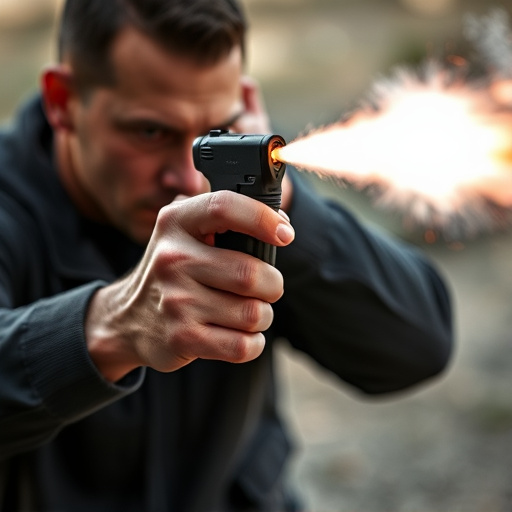Pepper spray, using capsaicin, offers a non-lethal defense with effectiveness tied to dose. The strongest legal concentration typically ranges from 2% to 5% capsaicin, temporarily disabling aggressors while adhering to legal guidelines. Global legality varies, with authorities setting maximum capsaicin levels (CU) and defining permitted uses. Strategic balance ensures potent protection without breaking the law. For optimal defense, focus on direct contact, close distance, low-light conditions, regular training, and legal accessibility.
“Uncover the ultimate self-defense tool—maximum strength pepper spray. This comprehensive guide explores the science behind this potent weapon, delving into its basic mechanics and how it temporarily disables attackers. We navigate the legal landscape surrounding pepper spray, highlighting regulations that ensure responsible use. Understanding what constitutes ‘maximum strength’ is crucial, as are strategies for effective defense. Whether you’re a professional or concerned citizen, arm yourself with knowledge on the strongest legal pepper spray concentration.”
- Understanding Pepper Spray: The Basic Mechanics
- Legal Considerations and Regulations Around Pepper Spray
- What Makes a Pepper Spray Maximum Strength?
- Strategies for Effective Defense Using Pepper Spray
Understanding Pepper Spray: The Basic Mechanics
Pepper spray, also known as oleoresin capsicum (OC) spray, is a non-lethal self-defense tool that uses capsaicin, the active ingredient found in chili peppers, to temporarily incapacitate an aggressor. When sprayed into the eyes and face, pepper spray causes intense irritation, leading to tears, reduced visibility, and temporary numbness. This disruption can create enough time for escape or the opportunity to call for help.
The effectiveness of pepper spray lies in its concentration—the higher the concentration of capsaicin, the stronger the impact. The strongest legal pepper spray concentration typically ranges from 2% to 5% capsaicin by volume. This concentration is powerful enough to render an attacker temporarily defenseless while still being considered legal for civilian use. Understanding how pepper spray works and knowing the right concentration can be a crucial element in personal safety and self-defense strategies.
Legal Considerations and Regulations Around Pepper Spray
In many jurisdictions, pepper spray is regulated as a less-lethal or non-lethal force tool, with specific laws and regulations dictating its use. The legality of carrying and using pepper spray varies widely between countries and even within states or provinces. One key consideration is the strongest legal pepper spray concentration allowed, which is typically measured in capsaicin units (CU). This concentration must fall within the permissible range set by local authorities to ensure public safety and prevent misuse.
Manufacturers and users must adhere to these regulations, ensuring that the pepper spray they produce or possess complies with the legal standards. Regulations often include rules on age restrictions for purchase, storage requirements, and permissible use cases, such as self-defense or law enforcement applications. Understanding these legal considerations is essential before purchasing or employing pepper spray as a defense mechanism to avoid any potential legal repercussions.
What Makes a Pepper Spray Maximum Strength?
Pepper spray, a powerful self-defense tool, is measured by its concentration or strength, typically expressed in percent capsaicin, the active ingredient responsible for the burning sensation it causes. Maximum strength pepper spray refers to those with the highest concentration of capsaicin, generally exceeding 10%. This potency makes it extremely effective against potential attackers, disabling them temporarily through irritation and pain.
The strongest legal pepper spray concentration is a balance between effectiveness and legality. Different jurisdictions have varying regulations on the permissible levels of capsaicin in self-defense sprays. These legal limits ensure that individuals can protect themselves while adhering to the law. Manufacturers carefully formulate their products to meet or exceed these standards, guaranteeing maximum strength without crossing into illegal territory.
Strategies for Effective Defense Using Pepper Spray
When considering maximum strength pepper spray defense, understanding effective strategies is key. Opting for the strongest legal pepper spray concentration available ensures maximum deterrence and impact. Aim for direct contact with the attacker’s eyes, nose, and mouth—these areas are most sensitive to capsaicin, the active ingredient in pepper spray. Holding the canister at a close distance (around 3-4 inches) will deliver a more concentrated blast, enhancing its effectiveness.
Additionally, practice using the spray in low light or no light conditions, as many encounters occur in dark alleys or during nighttime. Regular training allows for quicker reaction times and better control over the spray’s application. Always remember to keep your pepper spray readily accessible—in an easily reached pocket or holster—and ensure it’s legally permitted in your area.
In conclusion, understanding the mechanics of pepper spray, its legal framework, and what constitutes maximum strength are essential steps in selecting an effective defense tool. The strongest legal pepper spray concentration offers optimal protection without crossing into illegal territory. By familiarizing yourself with these aspects and employing strategic techniques, you can confidently use pepper spray for personal safety, ensuring you remain in control in potentially dangerous situations.
